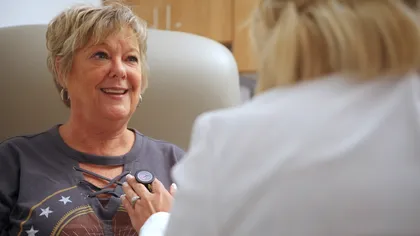Cancer Treatment and exercise
Exercise is an important part of a cancer treatment plan. A growing amount of research shows that regular exercise can greatly improve physical and mental health during every phase of treatment. Even if you were not active before your cancer diagnosis, an exercise program that meets your unique needs can help you get moving safely and successfully.
Benefits of exercise
Following a well-designed exercise plan during and after treatment may be able to:
- Lower the chance of having physical side effects, such as fatigue, neuropathy, lymphedema, osteoporosis, and nausea
- Reduce the risk of depression and anxiety
- Keep you as mobile and independent as possible
- Improve your balance to reduce fall injuries
- Prevent muscle loss and build strength
- Prevent weight gain and obesity, which are linked to increased cancer risk
- Improve sleep
- Decrease the amount of time you need to stay in the hospital
- Make your treatment more effective at destroying tumor cells
- Improve survival rates for certain cancers, such as breast cancer and colorectal cancer
- Reduce the risk of other cancers
- Prevent other chronic diseases, such as heart disease and diabetes
- Improve quality of life
Before you exercise during treatment
Always talk with your doctor before you start an exercise program during or after cancer treatment. While exercise is proven to be safe during different types of cancer treatment, your ability to exercise and the types of exercises you can do depends on:
- The type of cancer you have
- The treatments being used
- The side effects that you are experiencing
- Your level of fitness
- Your other health problems
If you were physically active before treatment, you may not be able to follow the same exercise routine as before. After treatment, it will take time to return to your pre-cancer fitness level. Ask your doctor to recommend a qualified cancer exercise specialist who can design the best exercise program for your unique situation. You may be able to follow the plan independently. Or you may need to work with the exercise specialist for some time.
What should be in your exercise program
A variety of different types of exercises is the key to a safe and effective exercise program during and after cancer treatment. In general, a complete program should include:
- Breathing exercises. Some people with cancer may have shortness of breath or difficulty breathing. This can keep them from being physically active. Breathing exercises help move air in and out of the lungs, which can improve your endurance. These exercises can also help reduce any stress and anxiety that causes your muscles to tighten.
- Stretching. Stretching regularly can improve your flexibility and posture. It helps increase the flow of blood and oxygen to the muscles, and it can help your body repair itself. Stretching is often helpful if you have been inactive while recovering from cancer treatments. For example, radiation therapy can limit your range of motion and cause your muscles to stiffen. After surgery, stretching can break down scar tissue.
- Balance exercises. Loss of balance can be a side effect of cancer and its treatment. Balance exercises can help you regain the function and mobility you need to return to your daily activities safely. Maintaining good balance also helps prevents injuries, such as falls. Learn more about balance exercises after cancer treatment.
- Aerobic exercise. Also known as cardio, this is a type of exercise that raises your heart rate. It strengthens your heart and lungs and can help you feel less tired during and after treatment. Walking is an easy way to get aerobic exercise. For example, your doctor may suggest walking 40 to 50 minutes, 3 to 4 times per week, at a moderate pace.
- The goal is to follow the U.S. Centers for Disease Control and Prevention (CDC) aerobic activity guidelines as closely as you can during and after treatment. The guidelines recommend 150 minutes per week of moderate-intensity exercise for adults. Or you can do 75 minutes of vigorous-intensity exercise.
- Strength training. Muscle loss often happens when a person is less active during cancer treatment and recovery. Some treatments also cause muscle weakness. Strength training, or resistance training, helps you maintain and build strong muscles. Increasing muscle mass can help improve your balance, reduce fatigue, and make it easier to do daily activities. It can also help fight osteoporosis, a weakening of the bones that some cancer treatments can cause.
The CDC recommends 2 days of full body strength training each week. A strength training program can include hand weights, exercise machines, resistance bands, and your own body weight. Learn more about safely strength training and stretching.
Exercising safely during treatment
It is important to take precautions while exercising if you are having side effects from your cancer or its treatment. You may have to change your exercise plan depending on your specific side effects. For example, if treatment is affecting the nerves in your hand, weight machines may be safer to use than hand weights. Or if treatment caused bone loss, you should avoid exercises that put strain on the neck and raise your risk of falling.
Here are other ways to make sure that you get the most out of your workout plan in a safe way:
- Progress slowly. Even if you were physically active before your treatment, build up your level of activity slowly. This can help you avoid injury and keep you from getting discouraged.
- Exercise in a safe environment. If treatment has weakened your immune system, avoid large gyms where germs spread easily.
- Listen to your body. If your energy level is low, adjust how long or how hard you exercise until you feel better.
- Stay hydrated. Drink plenty of water during your workouts to avoid dehydration.
- Eat a nutritious diet. The right foods, especially those high in protein, help your body recover after exercise. An oncology dietitian can help you develop a nutrition plan.
- See your doctor regularly. Your health can change throughout treatment. Make sure your doctor checks for important health indicators, such as your blood count, so you know if it is safe to exercise.









